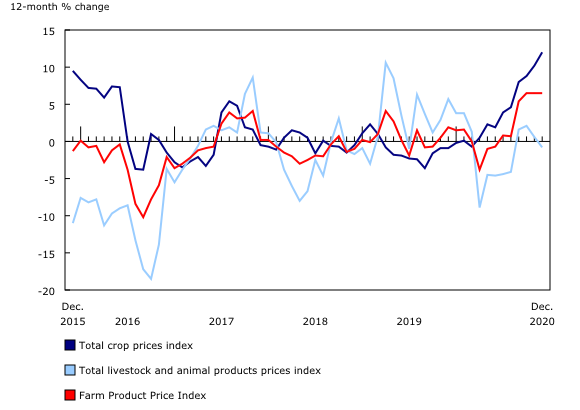Farm Product Price Index, December 2020
Archived Content
Information identified as archived is provided for reference, research or recordkeeping purposes. It is not subject to the Government of Canada Web Standards and has not been altered or updated since it was archived. Please "contact us" to request a format other than those available.
Released: 2021-03-04
The Farm Product Price Index (FPPI) rose 6.5% in December compared with the same month a year earlier, primarily as a result of higher prices for most principal crops.
The crops index was the main contributor to the increase in the FPPI, up 12.0% in December compared with the same month a year earlier. The increase in the crops index was driven by a good-quality crop and robust export demand for grains, oilseeds and specialty crops, which commanded high prices on the market in December. This was the ninth consecutive year-over-year monthly increase in the crops index.
The specialty crops index increased 31.5% in December compared with the same month a year earlier. Strong increases in lentil prices, followed by higher dry pea prices, were the main contributors to the rise. Strong demand for lentils from Turkey and India has continued to support prices. Canada shipped close to 50% more lentils in the first five months of the 2020/2021 crop year than in the same period in the previous crop year.
Year over year, the oilseeds index rose 17.2% in December, compared with December 2019, as the prices of all three major oilseed crops—canola, soybeans and flaxseed—continued to strengthen on higher demand. Canola, soybean and flaxseed exports were up 50.8%, 21.4% and 119.8%, respectively, in the last five months of 2020, compared with the same period a year earlier. A recovering hog industry in China boosted canola export numbers, and world oilseed, vegetable oil and protein meal prices strongly supported oilseed prices. A record pace for domestic canola crush in 2020, up 7.1% from 2019, also contributed to the strong demand for this crop.
The grains index rose 8.0% in December, supported mainly by bullish prices driven by a combination of strong demand for wheat from China, tightening supplies and a high-quality crop in the 2020/2021 crop year.
To a lesser extent, higher prices for fruit, vegetables and table potatoes also supported the increase in the crops index.
The livestock and animal products index declined slightly (-0.8%), mainly on lower prices for cattle and calves.
The cattle and calves index registered its 10th consecutive year-over-year monthly decline (-4.4%). Lower slaughter and feeder cattle prices ensuing from the persistent backlog of cattle because of processing disruptions related to the COVID-19 pandemic continued to put pressure on these prices. By the end of the year, slaughter levels in Canada were 4.0% lower than those of the year before.
Hog prices were more volatile over the year, ending with the December index 1.0% above the December 2019 levels, mainly because of higher slaughter prices. Despite lower slaughter levels for some months (April and November) in 2020 compared with 2019, hog processing capacity returned to, and even surpassed, slaughter levels observed before the pandemic-related disruptions. Total hog slaughter in 2020 ended up being 4.1% higher than in 2019—the highest level since 2014.
Higher prices in December for eggs and dairy moderated the decrease in the livestock and animal products index. The index changes for supply-managed commodities ranged from a decrease of 0.2% for poultry to an increase of 3.0% for eggs.
Note to readers
Find more agriculture and food statistics.
Support the 2021 Census of Agriculture.
Contact information
For more information, or to enquire about the concepts, methods or data quality of this release, contact us (toll-free 1-800-263-1136; 514-283-8300; STATCAN.infostats-infostats.STATCAN@canada.ca) or Media Relations (613-951-4636; STATCAN.mediahotline-ligneinfomedias.STATCAN@canada.ca).
- Date modified:


